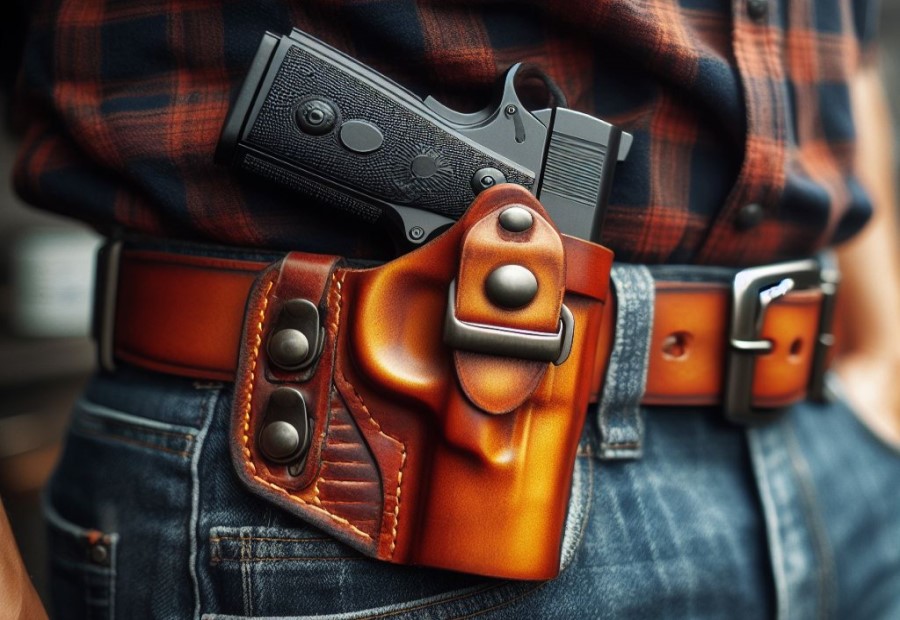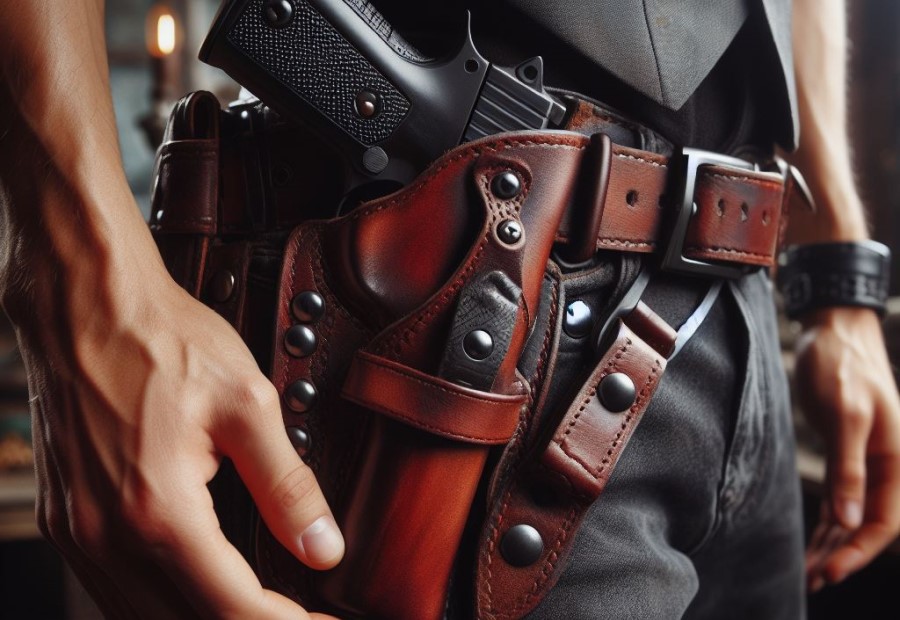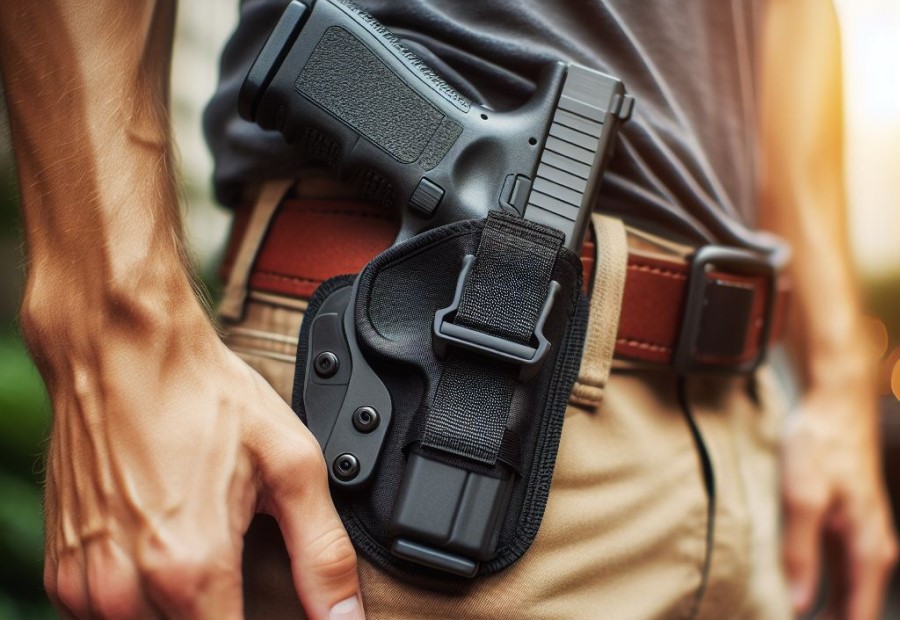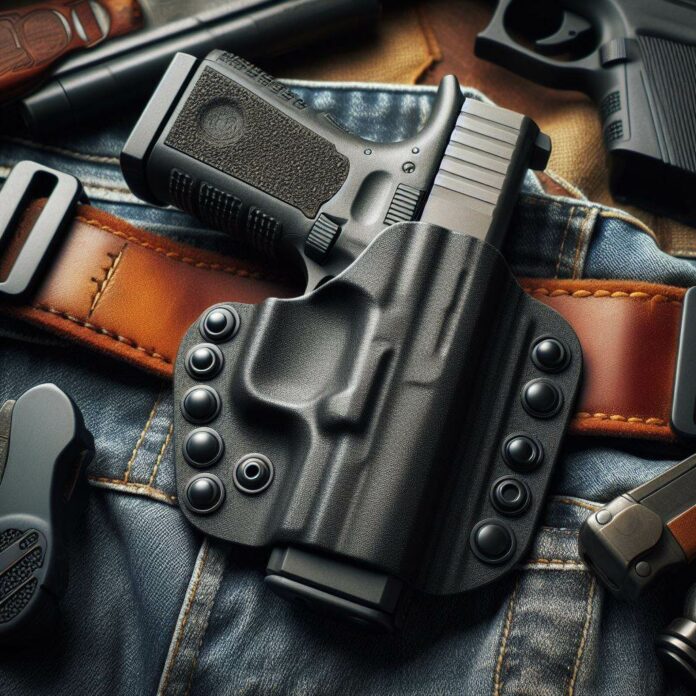A waistband holster is a popular and practical option for carrying a firearm discreetly and securely. It is designed to be worn inside the waistband of your pants, providing easy access to your firearm while keeping it concealed.
Understanding the different types of waistband holsters and their advantages and disadvantages can help you make an informed decision.
In this article, we will explore the different aspects of wearing a waistband holster, from choosing the right holster to practicing safe and comfortable wear. We will discuss essential safety considerations and precautions to ensure responsible firearm handling.
Whether you are new to waistband holsters or looking for tips to enhance your experience, this article will provide valuable insights into wearing a holster in the waistband. Let’s delve into the details.
What is a Waistband Holster?

When it comes to concealed carrying, one popular option is using a holster worn in the waistband. But what exactly is a waistband holster? In this section, we will uncover the ins and outs of waistband holsters, exploring the various types available.
From inside-the-waistband holsters to appendix carry options, get ready to discover the diverse range of waistband holsters that cater to different carry styles and preferences. Get ready to dive into the world of waistband holsters and find the perfect fit for your concealed carry needs.
Types of Waistband Holsters
- IWB Holster: This type of waistband holster, known as an Inside the Waistband (IWB) Holster, is specifically designed to be worn inside the waistband. It is typically secured with a clip or a strap, offering a high level of concealment. IWB holsters are popular among concealed carry permit holders.
- OWB Holster: An outside the waistband (OWB) holster is worn on the outside of the waistband and is usually attached to a belt. It provides easier access to the firearm but may be less concealed compared to an IWB holster.
- Appendix Carry Holster: The appendix carry holster is a type of waistband holster that is specifically designed to be worn in the front of the body, typically at the appendix position. It offers quick and easy access to the firearm, making it a popular choice for self-defense.
- Cross Draw Holster: The cross draw holster is another type of waistband holster that is worn on the opposite side of the dominant hand. This allows for a cross-body draw, which can be more comfortable for individuals who spend a lot of time sitting or driving.
- Belly Band Holster: The belly band holster is a flexible band that wraps around the waist and can be worn at various positions, including the waistband. It offers versatility in terms of positioning and can accommodate different firearm sizes.
- Ankle Holster: The ankle holster is specifically designed to be worn around the ankle, providing a discreet way to carry a secondary firearm or as a backup option. It is commonly used by law enforcement or individuals who need to carry a concealed firearm in a secondary location.
Why Choose a Waistband Holster?
When it comes to holsters, why should you consider choosing a waistband holster? Let’s dive into the advantages and disadvantages of using this type of holster. From increased concealment to easy accessibility, we’ll explore the benefits of a waistband holster.
But it’s not all sunshine and roses—there are drawbacks to consider too. Stay tuned to discover the ins and outs of waistband holsters and make an informed decision when it comes to carrying your firearm.
Advantages of Using a Holster in the Waistband
Firstly, it provides excellent concealment by being tucked inside the waistband, making it less visible to others. Additionally, a waistband holster ensures easy accessibility to the firearm, allowing for quick drawing in self-defense situations and enhancing response time.
Wearing a waistband holster is comfortable for extended periods as it is designed to be ergonomic and lightweight. It also features adjustable retention systems for a secure fit.
One of the notable advantages of a waistband holster is its versatility. It can be used with various clothing options like jeans, skirts, or dress pants, and can be worn in different positions such as appendix carry or strong-side carry.
Furthermore, many waistband holsters incorporate retention systems to hold the firearm securely in place, avoiding shifting or accidental falling during physical activity. In terms of convenience, waistband holsters surpass other types like shoulder holsters. They remain easily accessible even when seated or driving, providing practicality in everyday situations.
Disadvantages of Using a Waistband Holster
The disadvantages of using a waistband holster include:
- Restricted access: Some waistband holsters can make it difficult to quickly draw your firearm, especially if you are wearing bulky clothing or have limited movement.
- Uncomfortable fit: Depending on the design and material of the holster, wearing it against your body for extended periods of time can cause discomfort or irritation.
- Printing: Waistband holsters, particularly those with larger firearms, can sometimes create a visible bulge or print through your clothing, potentially revealing that you are carrying a weapon.
- Limited retention and security: Waistband holsters generally rely on a simple clip or hook to stay in place, which may not provide as secure a hold as other types of holsters, increasing the risk of accidental dislodging or loss of the firearm.
- Inadequate trigger protection: Some waistband holsters do not provide sufficient coverage for the trigger guard, which can increase the risk of unintentional trigger activation and potential injury.
It is important to consider these disadvantages when selecting a waistband holster and to prioritize safety, comfort, and ease of access based on your needs and preferences.
How to Properly Wear a Waistband Holster?

Discover the secrets of wearing a waistband holster the right way! Get ready to dive into the world of proper holster-wearing techniques, as we walk you through the essential steps. From selecting the perfect holster to finding the ideal placement, and mastering the art of safe drawing and reholstering, we’ve got you covered.
So, gear up and get ready to explore the ins and outs of proper waistband holster usage in this thrilling section.
Choose the Right Holster
When choosing the right holster for your waistband, it is important to follow Step 1: Choose the Right Holster. Here are the steps you should consider:
- Consider your firearm: Before choosing a holster, determine the type and size of your firearm. Different holsters are designed to accommodate specific firearms.
- Determine your carry position: Think about where on your waistband you would like to carry your firearm. Common options include appendix carry, strong side hip, or small of back.
- Choose the right material: Holsters are available in various materials such as leather, Kydex, or nylon. Consider factors like comfort, durability, and ease of draw when selecting the material.
- Decide on the retention level: Retention refers to how securely the holster holds the firearm. Choose a retention level that suits your needs and provides a balance between security and quick access.
- Consider your clothing: Take into account the types of clothing you typically wear, as this may influence the type of holster that will work best with your wardrobe.
By following these steps, you can choose the right holster that fits your firearm, comfort needs, and carry style.
Determine the Placement
When wearing a waistband holster, it is crucial to determine the proper placement for optimal comfort and accessibility.
- Identify your dominant hand: Determine which hand you will be using to draw your firearm.
- Choose the side of your waistband: Select either the right or left side of your waistband, depending on your dominant hand.
- Consider your body shape and clothing: Take into account your body shape and the type of clothing you typically wear. Ensure that the holster placement allows for easy access without printing or discomfort.
- Find the ideal position: Experiment with different positions along the waistband, such as the 3 o’clock or 4 o’clock position, to find the most secure and comfortable placement.
- Adjust for concealment: If you are aiming for concealed carry, position the holster in a way that allows your firearm to be hidden by your clothing while still being accessible.
- Test draw and reholstering: Once you have determined the placement, practice drawing your firearm from the holster and safely reholstering it to ensure smooth and efficient movements.
By following these steps to determine the placement of your waistband holster, you can ensure that your firearm is comfortably and securely positioned for quick access when needed.
Draw and Reholster Safely
- Before drawing, make sure your finger is off the trigger and pointed along the side of the holster.
- Hold the firearm securely and use your dominant hand to smoothly draw it from the holster in one continuous motion.
- As you bring the firearm out, keep it pointed away from your body and others in a safe direction.
- Once the firearm is out of the holster, remember to maintain proper trigger discipline by keeping your finger off the trigger until ready to shoot.
- When reholstering, guide the firearm back into the holster securely and ensure it is fully seated.
- Avoid rushing during the reholstering process to minimize the risk of accidental discharges.
- Practice a slow and deliberate reholstering technique until you feel comfortable and confident.
To safely draw and reholster, it is essential to prioritize proper handling and situational awareness. Always follow the fundamental rules of firearm safety and, if necessary, seek professional training. Remember, the goal is to handle the firearm responsibly and minimize the risk of unintentional harm.
Tips for Comfortable and Safe Wear

Looking to wear a holster in the waistband? We’ve got you covered with some valuable tips for a comfortable and safe experience. From finding the right size to practicing proper concealment, we’ll dive into all the essential aspects you need to know.
Plus, we’ll explore the importance of wearing a sturdy belt and maintaining good trigger discipline. Stay tuned for expert advice and practical insights to make your holster-wearing journey hassle-free!
Find the Right Size
When it comes to finding the right size for a waistband holster, follow these steps:
- Measure your waist: Use a measuring tape to determine the circumference of your waist where you plan to wear the holster.
- Refer to manufacturer sizing charts: Different holster manufacturers may have specific sizing guidelines. Check their sizing charts to find the size range that corresponds to your waist measurement.
- Consider your firearm size: In addition to your waist measurement, take into account the size of your firearm. Some holsters may require a larger size to accommodate larger firearms.
- Try it out: Once you have determined the size range, try on the holster to ensure a snug and secure fit. The holster should fit comfortably without being too tight or loose.
- Adjustability: Look for holsters that offer adjustable straps or retention systems, allowing you to fine-tune the fit for optimal comfort and security.
Finding the right size for your waistband holster is crucial to ensure a secure and comfortable fit, providing quick access to your firearm when needed.
Wear a Sturdy Belt
When wearing a waistband holster, it is important to wear a sturdy belt to ensure proper fit, support, and gun retention. Here are some steps to follow:
- Choose a high-quality, wide belt made specifically for carrying a firearm.
- The belt should be made of durable, stiff material such as nylon or leather.
- Ensure the belt is wide enough to comfortably support the weight of the holster and firearm.
- Adjust the belt tension to your desired comfort level, making sure it is snug enough to securely hold the holster in place.
- Secure the belt buckle tightly to prevent any slippage during movement.
- Regularly check the belt for any signs of wear or damage, and replace if necessary.
Practice Proper Concealment
When it comes to wearing a waistband holster, practicing proper concealment is crucial for safety and effectiveness. Here are some tips to help you do just that:
- Choose the right clothing: Opt for loose-fitting shirts or jackets that can cover the holster and firearm adequately.
- Position the holster correctly: Place the holster on the side or position that suits you best for quick and easy access while ensuring it remains concealed.
- Practice proper concealment: Adjust your draw technique to smoothly draw your firearm without alerting others to your actions. This includes maintaining a proper grip and minimizing unnecessary movements.
- Pay attention to body language: Avoid actions that may reveal the presence of your concealed firearm, such as excessive reaching, adjusting, or touching the holster area.
- Be mindful of your surroundings: Practice situational awareness to avoid situations where your concealed firearm may be accidentally exposed.
- Regularly check for printing: Take a moment to examine your concealed firearm in the mirror or ask a trusted companion to ensure there are no visible outlines or printing through your clothing.
By following these tips, you can practice proper concealment when wearing a waistband holster, ensuring your firearm remains hidden and secure.
Safety Considerations and Precautions
With safety as our top priority, let’s explore the key considerations and precautions when it comes to wearing a holster in the waistband. Discover the importance of firearms safety training and the significance of keeping the firearm securely and out of reach.
We’ll also delve into practical tips for avoiding accidental discharges while holstering, ensuring that you stay protected and in control. So, let’s dive into this essential knowledge to ensure a safe and confident carry experience.
Importance of Firearms Safety Training
Firearms safety training is crucial and should be given utmost importance when it comes to owning and carrying a firearm. It is essential to understand the potential dangers and responsibilities that come along with it. The knowledge and skills gained from firearms safety training enable individuals to handle firearms in a safe and responsible manner.
During these training programs, individuals are taught the proper techniques of handling, loading, aiming, and firing a firearm. They also receive education about various types of firearms and their functions. The training program emphasizes the significance of securely storing the firearm and ensuring it is inaccessible to unauthorized individuals.
Understanding the correct storage and transportation of firearms is a key aspect of firearms safety training. This involves storing them in a locked cabinet or safe and segregating them from ammunition. Moreover, individuals are educated on the importance of always treating a firearm as if it is loaded, regardless of its actual state.
Firearms safety training also includes comprehensive education on the legal and ethical aspects of owning and using a firearm. This encompasses understanding self-defense laws and knowing when it is appropriate to use a firearm for protection. The training also stresses the necessity of avoiding accidental discharges while holstering or handling a firearm.
By undergoing firearms safety training, individuals develop the necessary skills and mindset to handle firearms responsibly, ensuring the safety of themselves and those around them. The importance of firearms safety training cannot be overstated.
Keeping the Firearm Secure and Unreachable
When using a waistband holster, it is crucial to keep the firearm secure and unreachable. Follow these important steps to ensure that the firearm remains in a safe and inaccessible position:
- To keep the firearm secure, make sure to select a high-quality holster that properly holds it in place. This will prevent any accidental movement or dislodgment.
- Position the holster correctly on your waistband to ensure both comfort and security. It should be easily accessible for drawing the firearm while also remaining discreet.
- For additional security, consider using retention straps, thumb breaks, or other mechanisms provided by the holster. These features can enhance firearm retention and prevent unauthorized access.
- Practice trigger discipline by always keeping your finger off the trigger and outside the trigger guard until you are ready to fire. This practice prevents accidental discharges and ensures the firearm remains secure.
- Regularly inspect the holster for any signs of wear or damage. If necessary, replace the holster to maintain optimal security for the firearm.
- When not in use, store the holster and firearm securely in a locked case or safe. This additional step will further enhance security and prevent unauthorized access.
By following these steps, you can ensure that the firearm remains secure and unreachable while using a waistband holster.
Avoiding Accidental Discharges while Holstering
- To avoid accidental discharges while holstering, always ensure the firearm is unloaded.
- Keep your finger away from the trigger at all times when holstering.
- Choose a holster that fully covers the trigger guard to prevent accidental triggers.
- When holstering, maintain proper grip and control over the firearm.
- Stay focused and avoid any distractions or sudden movements during the holstering process.
- Regularly inspect the holster for any damages or defects that may cause accidental discharges.
- Minimize the risk of accidental discharges by avoiding quick or forceful reholstering.
Frequently Asked Questions
How should I wear a thigh holster?
A thigh holster, also known as a drop leg holster, should be worn on the thigh either outside or inside of pants. It provides discreet and natural access to the firearm.
What is the best carry position for a waist holster?
For a waist holster, the most common and popular carry position is the strong-side carry at the 3 o’clock or 9 o’clock position. This allows for quick access to the firearm.
What factors should I consider when choosing a holster for daily activities?
When choosing a holster for daily activities, you should consider your body type, personal preferences, and the type of clothing you typically wear. This will ensure that the holster is comfortable and properly concealed throughout the day.
How does the size of the firearm affect concealment in an IWB holster?
The size of the firearm can affect concealment in an inside-the-waistband (IWB) holster. Generally, full-size handguns may print more than smaller handguns. Adjusting the cant of the holster and using different belt clips can help improve concealability for full-size handguns.
What is the most common carry position for an IWB holster?
The most common carry position for an inside-the-waistband (IWB) holster is the strong-side carry at the 3 o’clock position. This position allows for easy access to the pistol with minimal movement.
Why is a suitable gun belt necessary for wearing an IWB holster?
A suitable gun belt is necessary for wearing an inside-the-waistband (IWB) holster because it supports the weight of the holster and firearm, preventing sagging or discomfort. It ensures a secure and comfortable fit for everyday carry.

